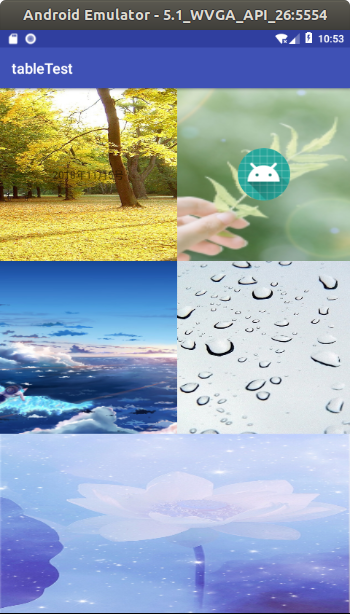将手机桌面划分区域,进行表格布局。
效果图:

layout.xml

<?xml version="1.0" encoding="utf-8"?> <TableLayout xmlns:android="http://schemas.android.com/apk/res/android" xmlns:app="http://schemas.android.com/apk/res-auto" xmlns:tools="http://schemas.android.com/tools" android:layout_width="match_parent" android:layout_height="match_parent" android:background="@mipmap/a2" tools:context=".MainActivity"> <TableRow android:layout_width="match_parent" android:layout_height="match_parent" android:layout_weight="1"> <LinearLayout android:layout_width="match_parent" android:layout_height="match_parent" android:layout_weight="1" android:background="@mipmap/a1" android:gravity="center" android:orientation="horizontal"> <TextView android:id="@+id/textView" android:layout_width="wrap_content" android:layout_height="wrap_content" android:text="2018年11月5号" /> </LinearLayout> <LinearLayout android:layout_width="match_parent" android:layout_height="match_parent" android:layout_weight="1" android:background="@mipmap/a2" android:gravity="center" android:orientation="horizontal"> <ImageView android:id="@+id/imageView" android:layout_width="wrap_content" android:layout_height="wrap_content" android:layout_weight="1" app:srcCompat="@mipmap/ic_launcher" /> </LinearLayout> </TableRow> <TableRow android:layout_width="match_parent" android:layout_height="match_parent" android:layout_weight="1"> <LinearLayout android:background="@mipmap/a3" android:layout_width="match_parent" android:layout_height="match_parent" android:layout_weight="1" android:orientation="horizontal"> </LinearLayout> <LinearLayout android:background="@mipmap/a4" android:layout_width="match_parent" android:layout_height="match_parent" android:layout_weight="1" android:orientation="horizontal"> </LinearLayout> </TableRow> <TableRow android:layout_width="match_parent" android:layout_height="match_parent" android:layout_weight="1"> <LinearLayout android:layout_width="match_parent" android:layout_height="match_parent" android:layout_weight="1" android:background="@mipmap/a5" android:orientation="horizontal"> </LinearLayout> </TableRow> </TableLayout>
图片可以自行在网上下载。放在res下面的mipmap-xhdpi,当然,其他几个放图片的地方也是可以存放的。
进行约束布局
效果图:

整个界面分为两部分,上和下,为线性布局,两张图片,其实这两张图片可以合起来连成一个背景。看起来就像是一张图片一样。比例为1:2
下面这张图片里面为约束布局,包含5张小图标,分别为进入,设置,帮助,退出,风云榜。
layout1.xml

<?xml version="1.0" encoding="utf-8"?> <LinearLayout xmlns:android="http://schemas.android.com/apk/res/android" xmlns:app="http://schemas.android.com/apk/res-auto" xmlns:tools="http://schemas.android.com/tools" android:layout_width="match_parent" android:layout_height="match_parent" android:orientation="vertical"> <LinearLayout android:layout_width="match_parent" android:layout_height="match_parent" android:layout_weight="2" android:background="@mipmap/top" android:orientation="horizontal"> </LinearLayout> <android.support.constraint.ConstraintLayout android:layout_width="match_parent" android:layout_height="match_parent" android:layout_weight="1" android:background="@mipmap/bottom"> <ImageView android:id="@+id/imageView2" android:layout_width="wrap_content" android:layout_height="wrap_content" android:layout_marginBottom="8dp" android:layout_marginEnd="8dp" android:layout_marginStart="8dp" android:layout_marginTop="8dp" app:layout_constraintBottom_toBottomOf="parent" app:layout_constraintEnd_toEndOf="parent" app:layout_constraintStart_toStartOf="parent" app:layout_constraintTop_toTopOf="parent" app:srcCompat="@mipmap/b0" /> <ImageView android:id="@+id/imageView3" android:layout_width="wrap_content" android:layout_height="wrap_content" android:layout_marginBottom="8dp" android:layout_marginEnd="8dp" android:layout_marginTop="8dp" app:layout_constraintBottom_toBottomOf="@+id/imageView2" app:layout_constraintEnd_toStartOf="@+id/imageView2" app:layout_constraintTop_toTopOf="@+id/imageView2" app:srcCompat="@mipmap/b1" /> <ImageView android:id="@+id/imageView4" android:layout_width="wrap_content" android:layout_height="wrap_content" android:layout_marginBottom="8dp" android:layout_marginEnd="8dp" android:layout_marginStart="8dp" app:layout_constraintBottom_toTopOf="@+id/imageView2" app:layout_constraintEnd_toEndOf="@+id/imageView2" app:layout_constraintStart_toStartOf="@+id/imageView2" app:srcCompat="@mipmap/b2" /> <ImageView android:id="@+id/imageView5" android:layout_width="wrap_content" android:layout_height="wrap_content" android:layout_marginBottom="8dp" android:layout_marginStart="8dp" android:layout_marginTop="8dp" app:layout_constraintBottom_toBottomOf="@+id/imageView2" app:layout_constraintStart_toEndOf="@+id/imageView2" app:layout_constraintTop_toBottomOf="@+id/imageView4" app:srcCompat="@mipmap/b3" /> <ImageView android:id="@+id/imageView6" android:layout_width="wrap_content" android:layout_height="wrap_content" android:layout_marginEnd="8dp" android:layout_marginStart="8dp" android:layout_marginTop="8dp" app:layout_constraintEnd_toStartOf="@+id/imageView5" app:layout_constraintStart_toEndOf="@+id/imageView3" app:layout_constraintTop_toBottomOf="@+id/imageView2" app:srcCompat="@mipmap/b4" /> </android.support.constraint.ConstraintLayout> </LinearLayout>
完成
